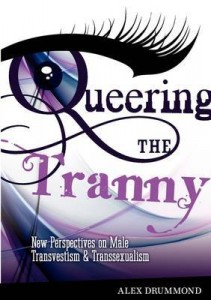A transgender and cognitive behavioral psychotherapist from the United Kingdom, Alex Drummond is out to help a 21st world better understand the notion of gender. In reality, western society in general takes gender for granted: We are born either male or female. It is a black-and-white issue with no room for asterisks, footnotes or alternatives. However, this is simply not the case, as Mr. Drummond makes clear in his work, Queering the Tranny: New Perspectives on Male Transvestism & Transsexualism (True Colours Publishing, 2011).
His book is in two parts: his graduate thesis, later followed by what is described as “auto-ethnographic methodology” – but do not let the latter distract you, because Drummond is simply telling us pertinent stories from his life, education and therapy practice. The material is easy to digest. The notion of gender, its grayness and malleability, however, is not.
How we perceive ourselves in the face of social context can often be daunting. For instance, what if a man is androgynous, desires sex reassignment surgery, or wants to wear women’s clothes? And even though Drummond’s work focuses on gender and its many facets, the book also serves as a catalyst for discussion about gender and its meaning. To start us off on an equal playing ground, Drummond gives us a glossary to help us along the way, with new some new words for a burgeoning lexicon, such as: boi, male-femaling, panopticonic, and tranny
Nomenclature aside, the work asks us to define ourselves while not bestowing our definition of gender upon others. Granted, this can lead to confusion, and may even leave someone feeling hurt. For instance, few may have thought that “tranny” would be viewed as something derogatory or harmful, yet it certainly can be – as does the term “she-male.” So, what do we call each other? More important, what is male and female – and what if you consider yourself to be somewhere in between?
Drawing upon the tried and true elements of appeal: ethos (ethics), logos (logic) and pathos (emotion), Drummond delivers a thoughtful and compelling work. Drawing upon his personal life helps us connect to the importance of his work as well as the struggle many others may be experiencing, such as family, friends, coworkers and classmates. For example, the story of a seven-year-old boy’s desire to become a chef while his testosterone enraged father wants his “poof” son to become a rugby player is extremely disconcerting as well as heartbreaking. As an educator in a conservative region, I have seen many college-age students bullied far too often due to gender ambiguity and sexual orientation, which brings additional impact to Drummond’s tales from across the Atlantic.
I wish Drummond had simply incorporated his academic work into the body of the narrative instead of keeping the material separate. The need to say, “this book is about” is repeated far too often and reeks of a novice writer. Interestingly, the notion of the “tomboy” is usually accepted in western society, and has been for many, many decades, as Drummond tells us. Yet, since the material focuses on male transvestism and transsexualism, this double standard in gender bending should be explored further, especially concerning why it occurs. Simple editing could make future editions of this pertinent ongoing study even more worthwhile, accessible and life giving.
Regardless of its shortcomings, Drummond’s book is as timely as it is helpful, for individuals, parents, counselors, educators and faith-based leaders, and I have no doubt many young lives – and maybe whole families – will be saved because of it.
Rating: Three out of five stars
William D. Prystauk is a guest reviewer this month.




Well done, Bill. Crisp and clear. Sensitive and intelligent review.